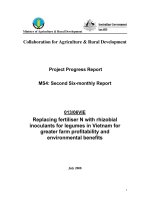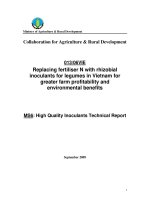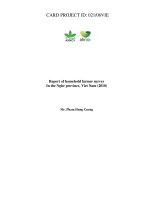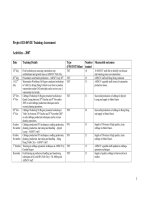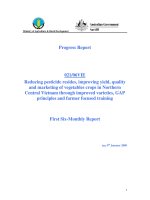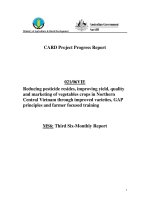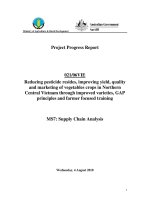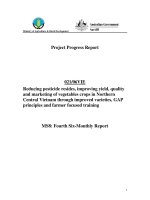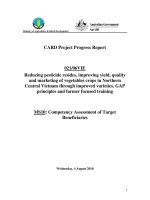Báo cáo khoa học nông nghiệp " Some solutions to protect and restore community based mangrove forests in Hau Loc Distric, Thanh Hoa rovince " pot
Bạn đang xem bản rút gọn của tài liệu. Xem và tải ngay bản đầy đủ của tài liệu tại đây (79.67 KB, 9 trang )
Hậu Lộc People Committee Engineer. Trịnh Cao Sơn
1
Some solutions to protect and restore community based
mangrove forests in Hau Loc Distric, Thanh Hoa rovince
Trinh Cao Son
Implementing organization: People Committee of Hau Loc District, Thanh Hoa Province
Summary:
Mangrove forest (RNM) of Hau Loc District has occurred for ages. The area of this
forest was some time up to hundreds of ha, and distributed in four communes of Xuan Loc,
Hai Loc, Hoa Loc, and Da Loc. However, under the overexploitation, particularly under the
conversion of mangrove forest into shrimp and crab farms as happened in Xuan Loc, Hoa
Loc, and Hai Loc, the mangrove forest area of the District has dramatically decreased.
Currently, there is no mangrove forest in Xuan Loc and Hoa Loc.
Mangrove forest plays an important role to protect effectively 12 km of coastal dyke
and mitigate natural disasters for people of Hau Loc District. Therefore, there is no way, but
to develop mangrove forest to protect costal line from tide and other disasters. From 1980,
Hau Loc has used fund and support from the Government and international organizations to
promote the planting and rehabilitation of mangrove forests. However, the planting has faced
difficulty as the survival rate of seedlings is quite low, just from 10-15%, and in some period
there is no seedling survived.
The main reasons are due to the alluvial site is far from the estuary (river mouth),
where the tide is strong and the mud is not solid enough. Specially, seedlings can dramatically
be destroyed by Barnacles (shipworm) as this species sticks and damages the tree.
Furthermore, the awareness of local people is limited, so that they harvest sea food and
firewood in the young mangrove forests. In addition, the economic conversion of region has
promoted opportunities for people to cut mangrove forest and develop sea food farms, also to
harvest existing sea food as those are the main income of local people. That is why for a long
time, the District had not been able to develop new mangrove forests, but in contrast a large
area of mangrove forest was destroyed. To solve the problem, the District has allocated the
old mangrove forest to the Frontier Post Number 114 for protection and management. At the
same time, the District has propagandized the role of mangrove forests to local people,
communities, agencies and local authorities. The District has researched and tried to answer
the question why the survival rate of mangrove seedling is low. The District has also initially
allocated mangrove forest to local and communities for projection and management.
Hậu Lộc People Committee Engineer. Trịnh Cao Sơn
2
Due to the above solutions, the area of mangrove forest has continuously increased
since 1996. The District had only 214 ha of mangrove forest for the period of 1996 – 2000,
but in the period of 2006 – 2009, 284 ha of mangrove forest were planted. That is due to the
finding of the reasons why the mangrove forests could not well develop, and appropriate
solutions to protect and restore mangrove forest based on local people and community who
are the direct beneficiaries.
I. Rationale and objectives of the project
1.1. Rationale:
Hau Loc is a coastal delta district, located in the north-east of Thanh Hoa Province. Its
total natural land is 14.367,19 ha, of which 1.170 ha are alluvial site that to be suitable for
planting forest and raising sea food. The District has 27 authority units (26 communes and 1
township). The total population of the District in 2009 was 163.971 people, with the density
of 11,4 persons/km
2
.
The District has 5 coastal communes (Da Loc, Minh Loc, Ngu Loc, Hung Loc, and
Hai Loc) locate in the East with the natural area is 3.442,25 ha (occupy 23,81% of total land
area of the District), the population is 57.068 people (34,8% of the district population)
surrounded by rivers: Len River in the North, Lach Truong in the South, East Sea in the East,
and the coastal line is 12 km. The coastal area of Hau Loc plays a very important role of
economy, politics and defence. This area has high density of residents, boasts for harveting
sea foods, and agriculture-forestry-aquatic processing products. Particularly, this area has a
system of coastal line, river banks, and infrustructures lying near the sea. Annually, the
District is heavily impacted by natural disasters, particularly from tropical typhoons. In
average, the District is annually directly impacted by 5 – 6 typhoons. The typhoon and rain
season starts from June and ends in November, in which August, September and October
could have a large number of typhoons, particularly strong typhoons.
The loss by natural disasters such as typhoons, strong tides and flood in the coastal
communes of the District is very large. From 2003 onwards, there have been many strong
typhoons, strong tides occured to dramatically damage the District. Typically, the typhoon
number 5 occured on 28/8/2003 and the typhoon number 7 occured on 27/9/2005 destroyed
and broke 3 km of coastal dyke without mangrove forests. Sea water therefore flowed into the
villages to destroy crops, houses and contructions. Thousands ha of cultivated soil were
infected by salt water, and the estimate of loss for the damage was hundreds of billions VND.
Futhermore, diseases occured widely and the daily life of local people faced difficulty.
Hậu Lộc People Committee Engineer. Trịnh Cao Sơn
3
However, it is very interesting that during that time, the 2km of coastal line covered by
mangrove forest were remained despite strong tide and wind.
Mangrove forest is a very important ecosystem of the natural environment. Mangrove
forest is considered to be a great coastal resource for the development of economy-society and
livelihood of local people. It plays as a green lung to ensure the development of the area. It
also provides local people with daily products such as crabs, cells, barnacle, fish, vegetable
and fruit. In addition, mangrove forest could maintain and protect soil from flowing by tide.
Particlarly, mangrove forest is known as “ green wall” to protect coastal line from strong tide
and wind. Therefore, it is very important for the protection of residents, their livelihood and
infrustruction.
Mangrove forest has been decreasing in both quantity and quality due to the un-
appropriate land use. The fast development of economies has negatively affected the
protection and rehabilitation of mangrove forest as this damages the structure and species of
the forest. This results in an decrement of quality and quantity of the forest. In addition,
human activities also impact on water resources, inflection of salt water and contamination of
soil and environment. Furthermore, the living standard of most local people is low,
particularly people working in agriculture – forestry – aquiculture sectors. The lack of land for
agriculture production is a serious problem for the locals. The awareness of local people of
protection of landscapes and mangrove forest is limited.
Due to the reasons above, we select the topic “Some solutions to protect and restore
community based mangrove forest in Hau Loc, Thanh Hoa” to share experiences and discuss
solutions to protect and restore the mangrove forest based on local community, and to sustain
the ecosystem and to improve income of the local people.
1.2. Objectives
* Environmental objectives
To increase the area of mangrove forest, improve ecological environment particularly
the coastal water environment, create habitat for sea organisms, and improve soil fertility. It
also means to contribute to the protection and development of aquatic products, strengthen the
durability of system of agriculture – forestry – aquiculture in coastal area.
* Social objectives
o To create jobs for local people, and limit the social evils.
o Improve awareness of community to protect mangrove forest in specific and to protect
the coastal landscape in general.
Hậu Lộc People Committee Engineer. Trịnh Cao Sơn
4
o Strengthen agreement within the community, and contribute to retain security and
defense.
* Economical objectives
Rehabilitate and develop mangrove forest resource in both quantity and quality, and to
partly meet the increasing demand for the firewood, aquatic and sea food of the local people,
also to improve their living standard.
Through the activities of rehabilitation and planting of mangrove forest, more jobs will
be created, so that it will improve income for local people in coastal areas. It also increases
the longevity of coastal dykes and other hydrological constructions, and to mitigate the impact
from the natural disasters.
2. Status and reasons for degradation of mangrove forest in Hau Loc District
2.1. Status
Mangrove forest distributes in 4 communes: Xuan Loc, Hai Loc, Hoa Loc, and Da
Loc. The best mangrove forest grows in Xuan Loc, then Hoa Loc, Da Loc and the worst forest
grows in Hai Loc. However, due to many activities such as the development of farms of sea
food, mangrove forest has been dramatically destroyed both in quantity and quality.
Currently, there is no mangrove forest growing in Xuan Loc and Hoa Loc.
Since 1980, the People Committee of the District has called for supports from the
Government, domestic and international organizations such as British Children Fund, Japan
Red Cross (JFC project), Japan organization for action and rehabilitation of mangrove forest
(ATM project) and CARE project for the rehabilitation of the mangrove forest. The District
has planted 464 ha of mangrove forest, of which 224 are mature forest (mostly Ixora) and 244
ha (Ixora 170 ha, and Sonneratia) and 74 ha of new forest planted from 2006 up to now.
2.2. Reasons for the degradation of mangrove forest in Hau Loc District
o People living in coastal area are poor, and their main incomes attained from the
exploitation of sea food from within and outside the mangrove forest, so that they can
damage young forests.
o There is a serious lack of cultivated land, so that local people destroy mangrove forest
for development of sea food farms.
o The awareness of local people of protection mangrove forest and landscape is limited.
o Local people lack firewood for daily consumption, also lack food to raise animal, so
that they harvest mangrove forest to meet their demand.
Hậu Lộc People Committee Engineer. Trịnh Cao Sơn
5
o Rubbish released from the district following the flow of the Lach Truong and Len
Rivers could damage mangrove trees, particularly the seedlings.
o The salt level of the water varies according to seasons of the year. The highest salt
level occurs in dry season, from November to the April next year. This is very suitable
time for shipworm to develop and damage young trees.
o The alluvial site for planting mangrove forest is normally not solid enough, so that
seedling of mangrove is easily flowed by tide.
o The money for tending and protection (mostly attained from 661 project) of mangrove
forest is very limited. Particularly, some area has no money for protection so that it is
very hard to sustain and develop the forests.
3. Some solutions to restore and protect mangrove forest based on community
Mangrove forest of Hau Loc District has been classified as protection forest. The
forest has not much value in terms of forest products and environment support services.
Therefore, the income received from the forest is very limited, so that the allocation of
mangrove forest to local people and community is difficult. However, with great effort from
the District and commune authorities and people, great support from international
organizations, the District has successfully restored 464 ha of mangrove forest, of which 244
ha are new plantation forests.
3.1. Some solutions for the success of the community based mangrove forest planting
At the moment, Hau Loc has 224 ha of old mangrove forest. This forest has been
planted on the most suitable sites near the estuaries of Lach Sung and Lach Truong Rivers.
New forest plantations will therefore be planted further to the sea, where the tide is bigger, the
salt level is greater, and the time covered by water is longer. Those conditions are good for the
shipworm to develop and destroy forests. This is one of the reason for the failure of the
mangrove forest plantations. Some people state that there is no way to plant more new
mangrove forest on the alluvial sites of Hau Loc. This has been approved by the planting
programs funded by Red Cross Association, 661 Project. Those programs planted 90 ha in
2005 and 2006. This forest however completely died after 1 year due to strong tide, strong
wind and the serious damage from shipworm. From the failure, we have learned experiences
to achieve the success of the current mangrove forest planting.
¾ Before the commencement of the mangrove forest planting, it is important to integrate
local authorities and people.
Hậu Lộc People Committee Engineer. Trịnh Cao Sơn
6
To organize meetings participated by local people, authorities, fish and sea food
harvesters to discuss and comment on the plan to plant, tend and protect mangrove forests.
To mobilize participation of local people to promote their experience and creativeness.
Local people understand their role in protection and development of mangrove forests. They
are also awareness of the importance of mangrove forest that provide them with benefit. This
is a very important issue as if neglect of it, the program will hardly be successful.
Local people should know all activities of the mangrove forest project. Local people
discuss and agree the schedules to plant, tend and protect forest following the general
principles from the Government.
For instance: Local people give comments on the best time to select fruit for seedling
production, and to avoid typhoons that normally occur from April in Da Loc, Hai Loc.
New forest should be planted as a bow-shaped range from the border with old forest.
This is experience from local people in Da Loc, Hai Loc.
¾ Technical transfer to participants and planting groups following the triangle method
Documents combining local experience and scientific
knowledge are applied to technical transfer/training
for groups of trainers. After that, trainers will transfer
knowledge and skills to other groups with help from
technical staff. Using this method, in a short time,
people could learn well how to plant, tend and protect
mangrove forest.
In the past, methodology was very simply introduced to
local people with much academy, so that after the course/workshop, local people were not
able to follow. Therefore, when planting in the field, many people did now know the right
method to plant, tend and protect of mangrove forest. In stead, they just followed the
traditional knowledge.
¾ Experience from CARE project
The Project invited experts and technicians, who had worked successfully with
mangrove forest plantation in Thai Binh Province to directly transfer knowledge and skills to
planting groups. The planting group has 121 members, who are outstanding people from
Woman Association and Famer Association of 6 coastal villages. They are then in charge to
transfer techniques to 700 farmers who are in charge to plant mangrove forests.
Model of training on planting
Hậu Lộc People Committee Engineer. Trịnh Cao Sơn
7
Regarding the establishment of mangrove forest to protect coastal dykes, they used
technicians from district and experienced staff from communes. Applying the training
techniques above, the project has achieved a great result as the survival rate of Sonneratia
could reach 90 – 95%.
3.2. Organize groups of farmers to successfully protect and tend mangrove forest
This is an important task to insure the survival of seedlings. It includes work of
cleaning barnacles (shipworm) and removing rubbish sticking on the seedlings.
In Da Loc, Hai Loc, some project have treated barnacles by using chemicals, but it
was not successful, and it damaged beneficial organisms such as crab, fish, shrimp within the
mangrove forest. Through direct survey in the young mangrove forest and meetings with local
people, the District understands why mangrove dies when planted on the sites with strong tide
and wind, and the solutions to those problems. Based on the indigenous knowledge learned
from meetings with local people, two solutions are as follows:
¾ Cleaning barnacles
Following local experience, barnacles annually have 2 breeding seasons. When
barnacles are young, we can clear them by hand without difficulty and without any damage to
the seedlings. Local community understands that cleaning barnacles is the most important task
to ensure the success of the mangrove forest. They are also awareness of the important role of
the mangrove forest, and they will benefit form this forest. Therefore, they are enthusiasms to
participate in planting mangrove forest despite the hard weather of the coastal areas.
¾ To ensure a large number of seedlings is not damaged by barnacles
Apart from planting bow-shaped range of mangrove by fruit in areas closed to old
forest, two experiences attained from local meetings to plant mangrove forest further to the
sea with conditions of high salt level, strong tide and wind are as follows:
o Planting mangrove forest using Ixora species
Use seedlings with their height of more than 50 cm growing in old forest or select old
fruits from old forest for producing seedlings in nursery. Standard seedlings will be planted on
sites of strong wind and tide.
When using this method, the mortality rate of seedlings is small as seedlings could
themselves protect from tide and wind. Particularly, the bark of seedlings is old enough to
reveal, so that they are not damaged by barnacles.
o Planting mangrove forest using Sonneratia
Hậu Lộc People Committee Engineer. Trịnh Cao Sơn
8
Good results have achieved from previous afforestation program and the enrichment
program using Sonneratia in Da Loc, Hai Loc. In fact, Sonneratia has long life-span, fast
growing and tolerance to high salt level, and could provide great biomass. Based on the
achievement, the District has expanded the area of mangrove forest using Sonneratia to attain
high productivity and effectiveness.
o Experience from CARE project
Establish a nursery to produce standard seedlings for the afforestation program. Local
people can also benefit from the nursery by selling seedlings and could also have good
seedlings for planting.
The dyke project provided local people in Da Loc and Hai Loc communes with
Sonneratia seedlings for planting in coastal dykes. After that, the authorities allocate the forest
to local communities to protect and manage the forests.
3.3. Protection of community forest
Enthusiasm residents living near the forest are selected to protect community forests.
Members of the community agree about the principle of activities implemented in the forest,
particularly in young forest. Local people managed community forest are mostly trained on
the role of mangrove forests, how to plant, tend and protect forest. The most importance for
the success of community forest is that all meetings, discussions and planning should involve
coastal community.
When conflict occurs, local authorities and frontier post number 114 are available to
overcome problems.
* Principles for the success in protection of community forest
- Organize meetings within the community to discuss issues of protection,
responsibility of member, role of forests, fund sources, and activities. They will
agree to establish general principle of “tending, protection and development of
mangrove forest”. This general principle is approved by District and a separate
management board and protection group from the community are nominated.
- District and commune authorities will assist community with the forest guard,
solve conflict of sea food and forest products. Develop principle between District,
local authority, Frontier Post Number 114 and forest owners.
- District provides community with some fund to protect forest according to the law
of the Government, to create opportunity for community to participate in forest
plantation project, programs associating with afforestation and reforestation.
Hậu Lộc People Committee Engineer. Trịnh Cao Sơn
9
3.4. Organize contests on "protection of environment and mangrove forest" to improve
awareness of local people and the young
Many kinds of contests have plentifully held in the District, such as: playing, drawing,
answering questions, and camping… The contests have attracted both people living near and
far from the mangrove forest. The contests were held in each commune, at school, on beaches
near the mangrove forest to show people the importance of mangrove forest. This is a good
method to increase the awareness of local people in terms of sustainable protection of
mangrove forest in specific and the ecological environment in general. This is also a very
good lesson for pupils to apply for their daily life and their future. The contests could also
contribute to help change the awareness and activities of local people pertaining to the
protection of mangrove forest and the environment.
The initial results have been achieved from the community based forest management
in Da Loc Commune that 200 ha of mangrove forest have been well managed by communities
of 3 villages of the commune. The new approach has been approved to be a good method for a
sustainable protection and rehabilitation of mangrove forest in the area.
Experience lesson:
The result clearly shows that the propagandism is very important to improve
awareness of local people and to mobilize communities. It is also very important that good
techniques on planting, tending and protecting mangrove forest should be also transferred to
local people. In addition, there is a need to assist community in developing a forest
management system based on communities.
It is necessary to expand this model into other regions, and increase funding for
planting and protection of mangrove forest to ensure the survival and development of the
forest.
